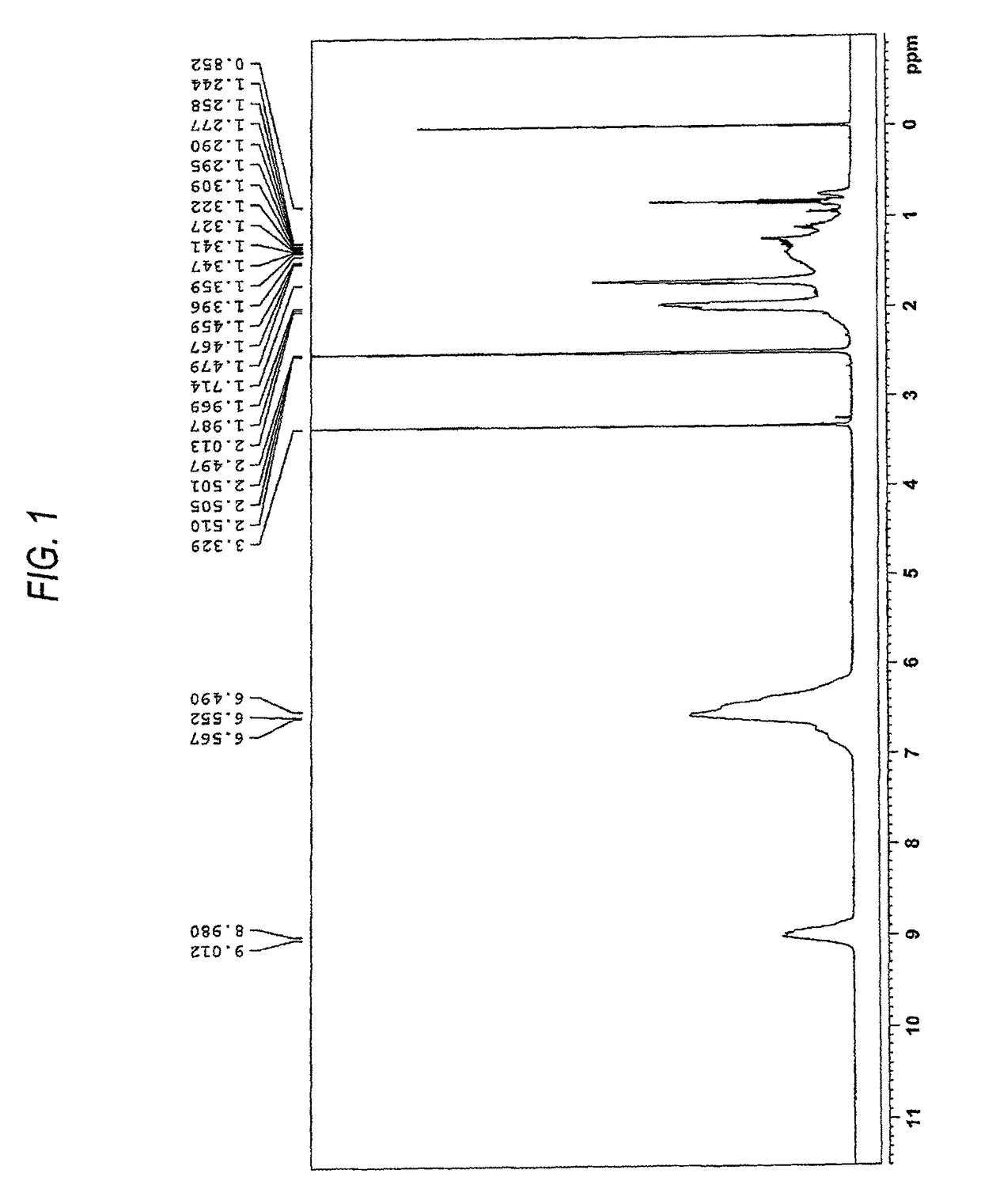Chemical amplification resist composition, resist film using the composition, resist-coated mask blanks, resist pattern forming method, photomask and polymer compound
a technology of resist substrate and composition, which is applied in the field of chemical amplification resist composition, resist film using the composition, resist pattern forming method, photomechanical apparatus, etc., can solve the problem of reducing the electron energy trapping ratio of resist film, increasing the effect of back scattering of electrons reflected in the resist substrate, and decreasing sensitivity
- Summary
- Abstract
- Description
- Claims
- Application Information
AI Technical Summary
Benefits of technology
Problems solved by technology
Method used
Image
Examples
synthesis example 1
Synthesis of Polymer Compound (A1)
[0297]In 120 mL of tetrahydrofuran (THF), 20 g of poly(p-hydroxystyrene) (VP2500) produced by Nippon Soda Co., Ltd. was dissolved, and 4.96 g of 1-adamantanecarbonyl chloride and 3.37 g of triethylamine were added thereto. The mixture was stirred at 50° C. for 4 hours, and the reaction solution was returned to room temperature. Thereafter, 100 mL of ethyl acetate and 100 mL of distilled water were added thereto, and an aqueous 1 N HCl solution was added little by little to the reaction solution to effect neutralization while stirring the reaction solution in ice water. The reaction solution was transferred to a separating funnel, and 100 mL of ethyl acetate and 100 mL of distilled water were further added. After stirring, the aqueous layer was removed, and the organic layer was washed with 200 mL of distilled water five times. The organic layer was then concentrated and added dropwise in 2 L of hexane. After filtration, the powder was collected and ...
synthesis example 2
Synthesis of Polymer Compound (A10)
[0298]In 100 mL of tetrahydrofuran (THF), 15 g of poly(p-hydroxystyrene) (VP2500) produced by Nippon Soda Co., Ltd. was dissolved, and 4.89 g of bicyclo[2.2.1]hept-5-ene-2-carbonyl chloride and 3.79 g of triethylamine were added thereto. The resulting mixture was stirred at 50° C. for 4 hours, and the reaction solution was returned to room temperature. Thereafter, 100 mL of ethyl acetate and 100 mL of distilled water were added thereto, and an aqueous 1 N HCl solution was added little by little to the reaction solution to effect neutralization while stirring the reaction solution in ice water. The reaction solution was transferred to a separating funnel and after removing the aqueous layer, the organic layer was washed with 200 mL of distilled water five times. The organic layer was then concentrated and added dropwise in 2 L of hexane, and the powder was collected by filtration and vacuum-dried to obtain 17.7 g of Polymer Compound (A10). FIG. 2 sh...
example 1e
(1) Preparation of Support
[0302]A Cr oxide-deposited 6-inch wafer (a wafer subjected to a treatment of forming a shielding film, which is used for normal photomask blanks) was prepared.
(2) Preparation of Resist Coating Solution
(Coating Solution Formulation of Negative Resist Composition N1)
[0303]
Polymer Compound (A1)0.60gPhotoacid Generator (z5) (the structural formula is shown0.12gbelowCrosslinking Agent CL-1 (the structural formula is shown0.08gbelowCrosslinking Agent CL-5 (the structural formula is shown0.04gbelowTetrabutylammonium hydroxide (basic compound)0.002g2-Hydroxy-3-naphthoic acid (organic carboxylic acid)0.012gSurfactant PF6320 (produced by OMNOVA)0.001gPropylene glycol monomethyl ether acetate (solvent)4.0gPropylene glycol monomethyl ether (solvent)5.0g
[0304]The solution of the composition above was microfiltered through a polytetrafluoroethylene filter having a pore size of 0.04 μm to obtain a resist coating solution.
(3) Preparation of Resist Film
[0305]The resist coat...
PUM
| Property | Measurement | Unit |
|---|---|---|
| carbon number | aaaaa | aaaaa |
| total carbon number | aaaaa | aaaaa |
| carbon number | aaaaa | aaaaa |
Abstract
Description
Claims
Application Information
 Login to view more
Login to view more - R&D Engineer
- R&D Manager
- IP Professional
- Industry Leading Data Capabilities
- Powerful AI technology
- Patent DNA Extraction
Browse by: Latest US Patents, China's latest patents, Technical Efficacy Thesaurus, Application Domain, Technology Topic.
© 2024 PatSnap. All rights reserved.Legal|Privacy policy|Modern Slavery Act Transparency Statement|Sitemap



